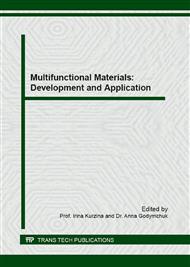[1]
M. Arruebo, M. Galan, N. Navascues,C. Tellez, C. Marquina, M. Ricardo, J. Santamaria, Development of magnetic nanostuctured silica-based materials as potential vectors for drug-delivery application, Chem. Mater. 18 (2006) 1911-(1919).
DOI: 10.1021/cm051646z
Google Scholar
[2]
H. Nobuto, T. Sugita, T. Kubo, S. Shimose, Y. Yasunaga, T. Murakami, M. Ochi, Evaluation of systemic chemotherapy with magnetic liposomal doxorubicin and a dipole external electromagnet, J. of Cancer 109 (2004) 627-635.
DOI: 10.1002/ijc.20035
Google Scholar
[3]
L. Jie, L. Monty, I. Jeffrey, T. Fuyuhiko, Mesoporous Silica Nanoparticles as a Delivery System for Hydrophobic Anticancer Drugs, Small, 3 (2007) 1341-1346.
DOI: 10.1002/smll.200700005
Google Scholar
[4]
M. Arruebo, R. Fernandez-Pacheco, S. Irusta, J. Arbiol, M. Ricardo Ibarra, J. Santamaria, Sustained release of doxorubicin from zeolite-magnetite nanocomposites prepared by mechanical activation, Nanotechnol. 17 (2006) 4057-4064.
DOI: 10.1088/0957-4484/17/16/011
Google Scholar
[5]
J. Yang, C. Hwan Lee, J. Park, Antibody conjugated magnetic PLGA nanoparticles for diagnosis and treatment of breast cancer,J. Mater. Chem. 17 (2007) 2695-2699.
Google Scholar
[6]
K. Ismailovа, V. Efremenko, A. Coregen, Biotechnology for the production of magnetic liposomes, J. Pharmaceutical Chem. (in Russian) . 39 (2005) 47-49.
Google Scholar
[7]
A. Coregen, Establishing the structure of magnetically active compounds produced by the new method, J. Pharmaceutical Chem. (in Russian). 41 (2007) 47-48.
Google Scholar
[8]
V. Belikov, A. Coregen, The receipt of the products of interaction of magnetite with pharmaceutical substances, J. Pharmaceutical Chemistry. in Russia. 38 ( 2004) 35-38.
Google Scholar
[9]
А. Rempel, Nanotechnology, properties and applications of nanostructured materials, J. Successes Chem. (in Russian). 75 (2007) 474-500.
Google Scholar
[10]
J. Duran, J. Arias,V. Gallardo, A. Delgado, Magnetic colloids as drug vehicles, J. Pharmaceutical Sci. 97 (2008) 2948-2983.
DOI: 10.1002/jps.21249
Google Scholar
[11]
N. Danilenko, G. Savel'ev, N. Yavorovskii, T. Yurmazova, Composition and Formation Kinetics of Erosion Products of the Metallic Charge in an Electric-Discharge Reactor, J. of Applied Chemistry. in Russia. 78 (2005) 1438-1443.
DOI: 10.1007/s11167-005-0534-2
Google Scholar
[12]
N. Danilenko, A. Galanov, Y. Kornev, P. Balukhtin, The usage of pulse electric discharges in water solutions for nanomaterials production and their usage in water purification, Nanotechnics in Russia. 8 (2006) 81-91.
Google Scholar
[13]
A. Galanov, T. Yurmasova, G. Savelyev, M. Buldakov, Development of magnetic nanostuctured iron-based materials as potential vectors for drug-delivery application, Siberian J. of Oncol. (in Russian) 27 (2008) 50-57.
Google Scholar


